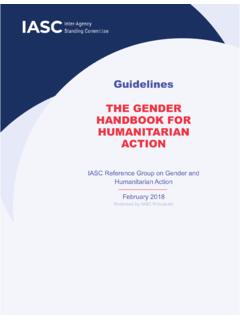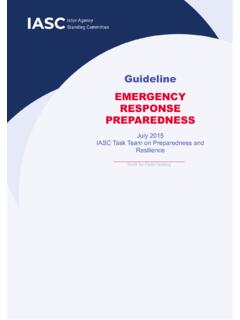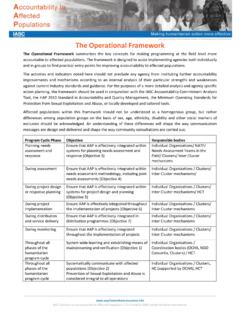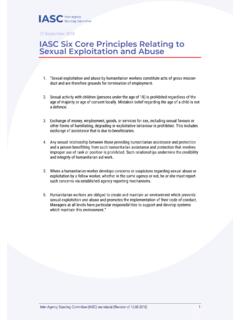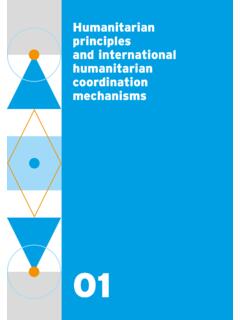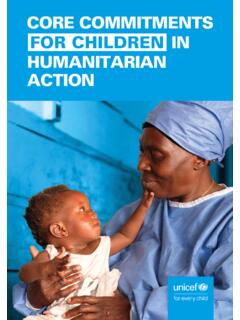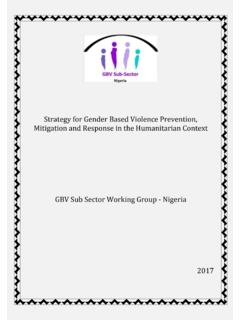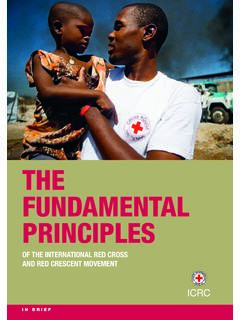Transcription of Guideline THE IMPLEMENTATION OF THE HUMANITARIAN …
1 Guideline THE IMPLEMENTATION OF THE HUMANITARIAN PROGRAMME CYCLE July 2015 HUMANITARIAN Programme Cycle Steering Group Endorsed by: IASC Working Group 1 THE HUMANITARIAN PROGRAMME C YCLEJULY 2015 IASC REFERENCE MODULE FOR THE IMPLEMENTATION OF VERSION 2 This document was prepared by the HUMANITARIAN Programme Cycle Steering Group of the Inter-Agency Standing Committee (IASC). It is primarily for managers of organizations that prepare for and respond to HUMANITARIAN crises. It provides an overview of what needs to be done, when and by whom, to enable managers to allocate staff and tasks, sequence decisions and planning, and identify priorities.
2 It does not describe how to do each action. For this, managers should refer to the technical guidance and templates available hardcopies of this document, please contact OCHA s Programme Support Reference Module will be revised periodically to take account of feedback from practitioners and further developments in guidance and Reference Module is one of eight protocols developed to support IMPLEMENTATION of the IASC Transformative Agenda. A summary of the protocols may be found in the NEW WAY OF WORKING ..1A SINGLE STRATEGIC PROCESS ..2 WHO IS INVOLVED.
3 3 FLEXIBILITY TO ADAPT ..3 HUMANITARIAN PROGRAmmE CYCLE ELEmENTS AND ACCOmPANYING TOOLS ..4 PREPAREDNESS ..5 NEEDS ASSESSMENT AND ANALYSIS ..6 STRATEGIC RESPONSE PLANNING ..8 HUMANITARIAN RESPONSE MONITORING ..10 RESOURCE MOBILIZATION ..11 OPERATIONAL PEER REVIEW ..12 INTER-AGENCY HUMANITARIAN EVALUATION ..13 ESSENTIAL ENABLERS ..14 Coordination ..14 Information AND ACCOuNTABILITY ..14 Accountability to Affected People ..14minimum Standards ..14 Protection ..14 Cross-Cutting Issues and Gender Equality ..15 Environment ..15 Resilience ..15 Exit and Early TImES AND TRIGGERS: POSSIBLE SCENARIOS SummARIZED.
4 16 Sudden onset crisis/escalation of crisis ..18 Annual or multi -year planning in protracted crises ..20 ANNEX: SummARY OF IASC TRANSFORmATIVE AGENDA PROTOCOLS ..214 MONTHSSEPTNOVDECI nter-agency humanitarianevaluationDAYSDAY 3 DAY 5 DAY 3-5 Flash appealDAY 14 DAY 14 / SEPTEMBERMIRA report/ HUMANITARIAN needs overviewDAY 30 DAY 90 DAY 90 / APRILP eriodicmonitoringreportOperationalpeerre viewwithin90 daysof crisisDAY 30 / NOVEMBERH umanitarian response planDECEMBERG lobal appeal / Overviewof HUMANITARIAN requirements 12 MONTHSOPERATIONAL PEER REVIEW & EVALUATIONSTRATEGICPLANNINGRESOURCEMOBIL ZATIONIMPLEMENTATION& MONITORINGNEEDS ASSESSMENT& ANALYSISPREPAREDNESSPREPAREDNESSPREPARED NESSRESPONSE MONITORING & REPORTINGD evelopmentof
5 HPCcalendarNEEDS ANALYSISRESPONSE PLANMONITORING AND REPORTING9 MONTHS IMPLEMENTATION AND DELIVERY IMPLEMENTATION AND DELIVERY APRSITUATION ANALYSISINITIAL PLANNINGNEEDS ASSESSMENT & ANALYSISHUMANITARIAN RESPONSE PLANMONITORINGPEER REVIEW & EVALUATION COORDINATION INFORMATION MANAGEMENTAFFECTED PEOPLESUDDEN ONSET / ESCALATIONPROTRACTEDThis graphic visualizes the key elements of the HUMANITARIAN programme cycle in the central core.
6 The next two rings represent the indicative steps in sudden onset crises or sudden escalations in an existing crisis, and in the annual planning cycle of protracted crises respectively. The outer ring depicts the operationalization of these elements through IMPLEMENTATION and delivery. The HUMANITARIAN programme cycle provides a framework for the delivery of aid to meet the needs of affected people quickly, effectively and in a principled manner. This framework applies to all HUMANITARIAN crises but the process, timeline, tools and documents can be used flexibly.
7 1A NEW WAY OF WORKINGU nder the IASC Transformative Agenda, the IASC Princi-pals committed to the ultimate objective of accountability to affected people by ensuring that the HUMANITARIAN response delivers assistance to those in need as the result of effective and timely decision- making and plan-ning. In December 2011, IASC Principals agreed to a set of actions that collectively represent a substantive improvement to the HUMANITARIAN response model. These include: A mechanism to deploy strong, experienced senior HUMANITARIAN leadership to guide the HUMANITARIAN response from the outset of a major crisis; The strengthening of leadership capacities and rapid deployment of HUMANITARIAN leaders at various levels, to ensure the coordination architecture functions well; Improved strategic planning at the country level that clarifies the collective results that the HUMANITARIAN community sets out to achieve and identifies how clusters and organizations will contribute to them.
8 Enhanced accountability of the HUMANITARIAN Coordi-nator (HC) and members of the HUMANITARIAN Country Team (HCT) for the achievement of collective results; and Streamlined coordination mechanisms adapted to operational requirements and contexts to better facil-itate States have the responsibility first and foremost to take care of the victims of natural disasters and other emergencies occurring on their territory, international cooperation to address emergency situations and strengthen the response capacity of affected countries is of great importance given that the magnitude and dura-tion of many emergencies may be beyond the response capacity of many affected HUMANITARIAN programme cycle (HPC)
9 1 is about a 1 The HUMANITARIAN programme cycle concept is inclusive of elements of the former consolidated appeal process (CAP).There is no one size fits all approach to the application of the HUMANITARIAN programme cycle. Tools should be applied flexibly and in a light touch manner to ensure evidence-based, prioritized responses and periodic reporting on results in support of the delivery of HUMANITARIAN protection and on refugee and mixed situation operations: The Joint UNHCR-OCHA Note on Mixed Situations: Coordination in Practice clarifies leadership and coordination arrangements in the situation where a complex HUMANITARIAN emergency or natural disaster is taking place, a HUMANITARIAN Coordinator has been appointed, and a UNHCR-led refugee operation is also underway.
10 The note sets out the respective roles and responsibilities of the UNHCR Representative and the HC, and the practical interaction of IASC coordination and UNHCR s refugee coordination arrangements, to ensure that coordination is streamlined, complementary and mutually new way of working, building on what the humanitar-ian system has learned. This IASC Reference Module defines the roles and responsibilities of international HUMANITARIAN actors and the way that they interact with each other, with national and local authorities, with civil society, and with people affected by HUMANITARIAN programme cycle consists of a set of inter-linked tools to assist the HUMANITARIAN Coordinator2 and HUMANITARIAN Country Team to improve the deliv-ery of HUMANITARIAN assistance and protection through better preparing, prioritizing, steering and monitoring the collective response through informed decision-making.
